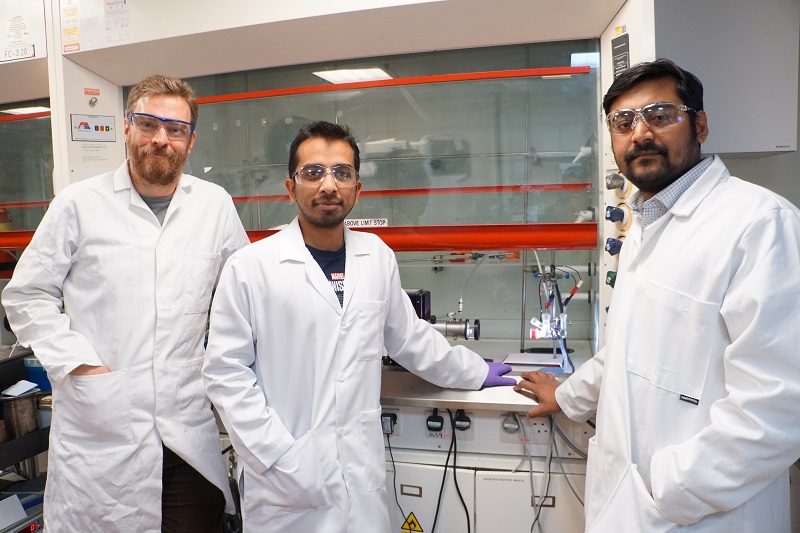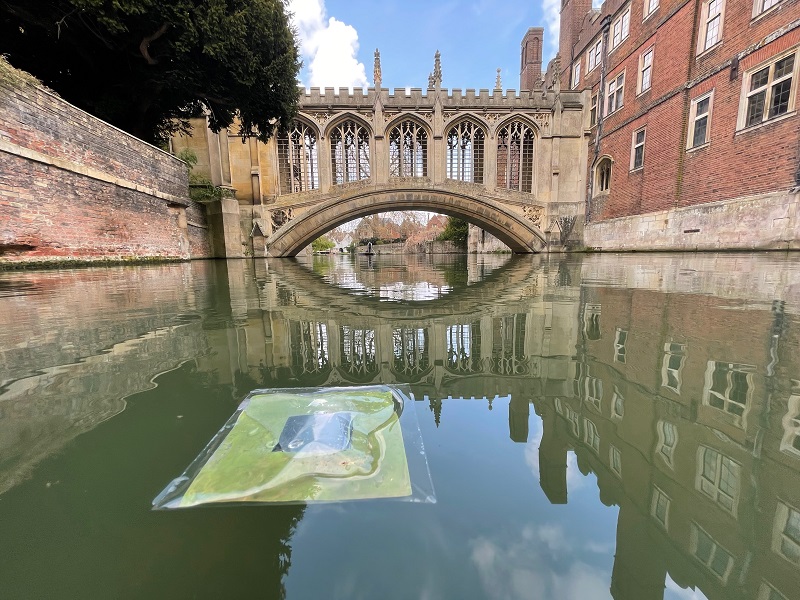Professor Sunshine: the blue-sky thinker using solar energy to create green fuels
“We always look in our science for new applications, unexplored niches where we can deploy our systems”
Meet Professor Erwin Reisner, whose innovative Cambridge research team harnesses sunlight to turn rubbish and CO2 into sustainable fuels. He explains why he chose this challenge, and reveals the balance between working for the greater good and day-to-day problem solving in the lab.
At the start of 2023, a year promising no let-up in the threats facing the planet, Professor Erwin Reisner and his team at Cambridge’s Yusuf Hamid Department of Chemistry published a paper whose findings seemed almost miraculous. A reactor developed by the researchers could, they revealed, transform both plastic waste and greenhouse gases into sustainable green fuels and other valuable products, powered solely by energy from the sun.
The system, the journal Nature Synthesis reported, would be the first solar-driven reactor to convert two different types of waste – which happen to be two of the biggest threats facing the natural world – into two beneficial chemical products at the same time. It would convert carbon dioxide into syngas – a synthetic gas used to make green liquid fuels in place of oil-derived petroleum and kerosene, while plastic bottles would be turned into glycolic acid, widely used in skincare products.
It sounds almost too good to be true, yet it isn’t. The system, with the potential to be a game-changer in the development of a circular economy, is exactly the kind of product the Reisner Lab, and particularly the Cambridge Circular Plastics Centre (also led by Erwin), were set up to create: it combines imaginative blue-sky thinking with practical measures hammered out through careful research. “Our job as academics is to create and promote new solutions and technologies,” says Erwin, Austrian-born Professor of Energy and Sustainability at Cambridge and a Fellow of St John’s for 13 years. “My privilege as an academic is that I can be a dreamer and a visionary and have the time to develop new ideas and systems.”

Erwin, who leads a 25-strong lab made up of half PhD students and half postdocs, focuses his research on sustainable fuels rather than green electricity generation. “We are not interested in electricity generation; for me, as an academic, that is done. Hydrogen is also done, I don’t think it needs me.” Electricity, he points out, represents only a fifth to a quarter of energy demand globally, while the rest is supplied by fuels that must be made renewable if global decarbonisation targets are to be achieved. His particular target is “the difficult last 10 per cent” of fossil fuel use that will not easily switch to sustainable sources, mainly in the oil-guzzling transport and chemical industries.
“We have to work for the greater good”
The lab’s journey to developing the twin waste reactor began with work on converting the greenhouse gas carbon dioxide, or CO2, into syngas using solar power. The researchers developed a ground-breaking ‘artificial leaf’– an ultra-thin flexible device taking its inspiration from plant photosynthesis. Light enough to float on water, the leaves use just sunlight, carbon dioxide and water to create syngas, raising the prospect of clean fuel generation at sea to serve shipping or remote island and coastal communities.
Alongside the water-based trials, the team experimented with biomass waste – non-edible plant or animal waste such as grass clippings, manure or paper – and found that, too, could be broken down to produce clean fuel. Finally, by accident, Erwin’s researchers discovered that the system worked on plastic waste, which would otherwise end up in landfill. “We analysed a failed experiment and found this by chance,” he says. “This is also why academic freedom is so important, and being able to spend time on something where it is not clear what the outcome will be… There should be more flexibility to really build something completely novel and innovative. We always look in our science for new applications, unexplored niches where we can deploy our systems.”
Even after devising and proving brilliant new concepts, the next challenge for labs such as Erwin’s is to introduce the technology in the real world. When a solution is already available, like the cheap production of hydrogen from natural gas, it can be hard to break in – even for a green replacement for a fossil technology. “Our commercialisation ambitions are affected by this,” says Erwin, “but I recognised it early and we’re now very close to having a start-up company. Perhaps it’s because we were pushed so hard by the constraints of the existing energy industry that we produced two products in one device. We needed to be imaginative in our thinking to compete with an industry that has been going for 150 years and is completely dominant. It is always hard for small start-ups and new technologies to come in and occupy that space.”

There is, clearly, an urgency to the research of the Reisner Lab and others in the same field in the light of the climate crisis. The effect of that pressure on himself and his team is mixed, Erwin says. “There are two layers. In my own position, I have a responsibility to really look into this and provide potential solutions and develop these technologies. I think they should be tied into societal interests: we have to work for the greater good. So for me, it means making the world a better place, providing sustainable solutions and making sure we don’t boil and eventually end up like a little Venus.
“I like the idea of a solar-powered recycling plant where we put all our trash in and out come the fuels or the drugs or the vaccines”
“But day-to-day in the lab we don't really see it. It’s very important to take what we are doing into the real world, but your daily motivation can't be that: you’re just solving scientific puzzles and troubleshooting all day long.”
Back out in the real world, there are ‘huge opportunities’ and economic advantages to breakthroughs like the solar reactor. “This will be where all the future is – the biggest economic opportunity of our century and governments should embrace it fully.” The problem, he notes, is short termism, a ‘hype-bust cycle’ in which funding lasts two or three years, and is then cut. When the public focus fell on ocean plastics after Sir David Attenborough’s 2017 Blue Planet II series, ‘activity and funding exploded in the UK’ to address plastic pollution, but then not sustained again as government priorities moved elsewhere.
To keep the case for energy science in the public eye, Erwin and his team work hard to communicate their work. The lab’s website explains the reactor and other breakthroughs at a variety of levels, including some appealing stop-start Lego animations set in ‘Bricktown’ in which mini-figures make use of renewable energy. Erwin visits schools and ensures he does something ‘outreach-related’ every month. His next venture into public engagement is especially tempting: a ‘Pint of Science’ talk in a local pub.
As for the future, he sees no limit to the possibilities for developing the Lab’s work. “Our dream is to use sunlight to make any chemical you want. Why not to make drugs, pharmaceuticals from CO2? I like the idea of a solar-powered recycling plant where we put all our trash in and out come the fuels or the drugs or the vaccines. And we hope for support to make this a reality.”
Chemists like himself, he argues, have a critical role in ‘showing you can really open a sustainable chemical space and be a ‘clean chemist’.” But alongside such serious goals, there is a lighter side too. “It’s also fun. You’re always learning something new. My research group includes material scientists and physicists as well as chemists and microbiologists: this topic is so broad. I just love my day-to-day routine: solve little puzzles, work with great people, come up with new ideas and think about something good for society too.”
Published 6/4/2023